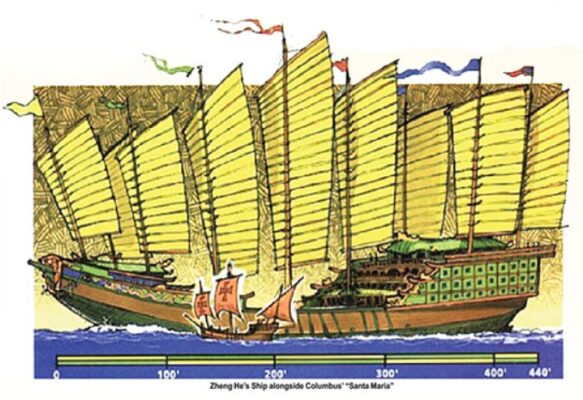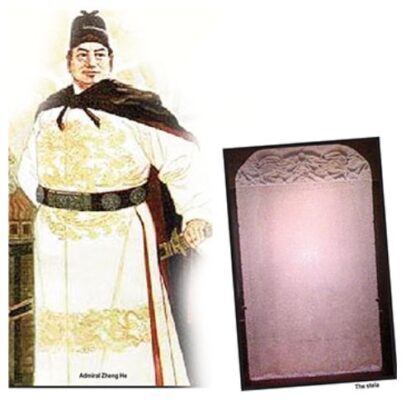Chinese Admiral Zheng He’s trilingual stela in Galle-by admiral Ravindra c Wijegunaratne

Source:Island
A plaque erected to mark the opening of a new electronic library at the Attorney General’s Department was removed because the writing thereon was only in Sinhala and English, and Tamil had been left out. This reminded me of a stone plaque bearing the date 15th February 1409 put up by Chinese Admiral Zheng He at Galle harbour during one of his grand voyages to Sri Lanka, India and the African Continent.
 Zheng He was a Chinese mariner, explorer, diplomat, fleet admiral , and court eunuch during China’s early Ming Dynasty. Born as Ma He or Ma Sanbao into a Muslim family in 1371, he later adopted the surname Zheng conferred by the Yongle Emperor. He completed seven historical voyages to do trade and gather knowledge from other parts of world. He died in 1433, at the age of 62, during his last voyage near Calicut (now Kozhikode), India. His remains were dropped to Davy Jones’ locker (buried at sea) off Corramandal coast of India.
Zheng He was a Chinese mariner, explorer, diplomat, fleet admiral , and court eunuch during China’s early Ming Dynasty. Born as Ma He or Ma Sanbao into a Muslim family in 1371, he later adopted the surname Zheng conferred by the Yongle Emperor. He completed seven historical voyages to do trade and gather knowledge from other parts of world. He died in 1433, at the age of 62, during his last voyage near Calicut (now Kozhikode), India. His remains were dropped to Davy Jones’ locker (buried at sea) off Corramandal coast of India.
Zheng He had his voyages a long time before the European powers visited this part of the world. (The Portuguese first landed in India on 20 May 1498). Zheng visited Sri Lanka almost a century before him, and his stone stela is about the offerings he made to the Buddha, Allah and Hindu God Vishnu seeking their blessings for successful trade with Sri Lanka.
Sinhala omitted
Now, this historical stela is at the National Museum, Colombo. What he offered to Buddhist temples, Mosques and Hindu temples is fascinating and the whole list has been inscribed on the stela, which erected in a predominantly Sinhala area, is in three languages—Tamil, Persian and Chinese; he omitted Sinhala!
Admiral Zheng He’s fleet was unbelievably large. He had sailing ships which were more than 120 metres in length (longer than the Sri Lanka Navy’s flag ship) and had five decks each. Unconfirmed stories say their crews grew fresh vegetables on the top decks and had piggeries in the bottom bilge decks, where pigs were fed with leftover food of the crew during passage. These ships were floating fortresses.
 Admiral Zheng He had more than 100 ships of this size and smaller vessels; his fleet consisted of 217 ships and 28,000 sailors/marines. In comparison, Columbus in 1492 had only three ships and 90 sailors. “Santa Maria”, the flag ship of Columbus, was only 30 meters in length.
Admiral Zheng He had more than 100 ships of this size and smaller vessels; his fleet consisted of 217 ships and 28,000 sailors/marines. In comparison, Columbus in 1492 had only three ships and 90 sailors. “Santa Maria”, the flag ship of Columbus, was only 30 meters in length.
Admiral Zheng He’s big ships carried valuable cargo like silk, gold and silver coins, porcelain vases and plates for trading around the world.
When Admiral Zheng He first visited Sri Lanka in 1405 at the Beruwala harbour, which was popular among Arab traders at that time, he visited the Kotte Kingdom and climbed Sri Pada. His first visit was only limited to India and Sri Lanka. During his second voyage in 1411, he clashed with the Kotte kingdom, and King Alakeshwara tried to attack his ships. The Admiral launched a counterattack with his expeditionary forces and captured Alakeshwara, who was subsequently replaced with King Parakramabahu VI. He sailed to China with the Sinhalese prisoners, including King Alakeshwara.
According to historical records, Admiral Zheng He presented captured King Alakeshwara and his followers to Yongle Emperor (third Emperor of Ming dynasty), only to be told that the Chinese went on voyages to promote their trade and not to wage war, and ordered to take the captives to Sri Lanka during his next voyage itself. The Admiral took them back to Sri Lanka, as ordered by the Emperor. They were looked after well during their stay in China.
The present-day Chinese leaders have said the same thing as regards their Belt and Road initiative: “We are for trade and investment and not war.”
After his sixth voyage Admiral Zhang He concluded that there was nothing China could learn from the outside World. True enough, China was very much advanced compared to the  outside world at that time. He reported this to the Emperor, who later had the fleet dismantled after the Admiral’s last voyage and funds were utilised for keeping the Mongolian invaders at bay. Admiral Zheng He spent 28 years of his adult life on voyages.
outside world at that time. He reported this to the Emperor, who later had the fleet dismantled after the Admiral’s last voyage and funds were utilised for keeping the Mongolian invaders at bay. Admiral Zheng He spent 28 years of his adult life on voyages.
Puzzle
In 1911, S.H. Thomlin, a British engineer working in Galle along the southwestern coast of Sri Lanka, found the stone tablet lying in a culvert.
I am only a seafarer and not a historian. Can someone enlighten me on why the Sinhala language was not used in this plaque?
Were the Sinhalese upset and angry then as there was no inscription in Sinhala. Let us have a discussions on this interesting subject.
(I will be failing in my duty if I do not mention the help I received from Ravi junior for gathering some historical details.)







